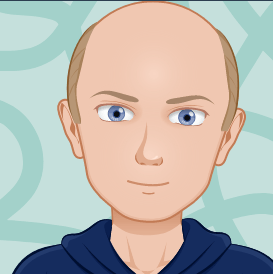
You run, you jump, but you can’t out-run or out-jump your fate. A reassuringly simple metaphor, or a frustrating dud? You decide.
About the game
It’s hard to tell who you are – there’s no backstory. You’re thrown right in the middle of the action. You begin to sprint down a corridor, and before you know it, the window smashes. Hopefully, you land on a rooftop.
From there, “Canabalt” is just more of the same. Running and jumping. The only way to control your character is by making them jump: everything else (running, speeding up, slowing down on obstacles) is done without much input from you. Jumping gets you from one city rooftop to another, in and out of more corporate-looking corridors, over obstacles and bombs.
Yes, bombs: your city seems to be under attack. Are those spaceships? Is that a gigantic alien robot in the background? The game won’t let you slow down for long enough to find out, and really, it won’t matter. There is no happy ending here: the game’s goal is to run as far as you can. But sooner or later, you’ll mis-time your jump, or lose too much speed to make it to the next rooftop, or you’ll get blown up by a bomb. Game over.
(Edit: the recent reboot of the game added more areas, more achievements, and divided the experience into episodes around a map. I don’t think it’s the same game anymore, for reasons listed below.)
About what it taught me
I first played “Canabalt” over 10 years ago, in a teacher’s lounge. Back then, it was a competitive thing: a bunch of teachers were competing to see who would run the farthest. This made it addictive without too much effort, and taught me how easy it is to get a small community drawn in: measure one thing, and have them compete to see who is best. (Maybe it mattered that only the guys played it in that teacher’s lounge.)
Coming back to the game later, I learned how “Canabalt” managed to get one more thing right. It never gave any backstory, any tutorial, or explanation. Some games just wouldn’t be able to make it work. This game did: part of the reason for coming back was the hope that, if I manage to run far enough, I may be able to get some more answers, or a glimpse of another detail which would explain the game to me.
It never did. It never got easier, or harder, or different. It never even hinted at a way out. It always, always ended badly. This frustration was the last thing the game taught me. “Canabalt” didn’t try to design the frustration away: it was built around it. That’s how I got better at it. I learned to use the obstacles to slow me down, and to time my jumps. The frustration of each failed attempt was a stimulus to try again: after all, the game wouldn’t be different, just…more of this.
Not just me?
In video games, frustration is a topic worth discussing. “To rage-quit” is a verb describing the act of quitting a game which really, really p*sses you off. Outside of creative lexicology, researchers seemed to find that frustrating games lead to violence – possibly explaining more of the violent behaviour than the content of games frequently stigmatised by the media.
In learning, though, it might be a different story. Learners who encountered frustrating attempts, according to this piece of research, found them instructive and treated them as more learning opportunities. This mirrors my experience of “Canabalt”, albeit in a limited way. Playing the game today, I found I was still able to pick it up quickly – possibly because of all the frustration-inspired skills I acquired in the past.
What it will cost you
The first version of the game worked in browsers, and was free to play. Nowadays, you can get it on Apple and Android devices, and on Steam – but you’re expected to pay a few pounds for it.
Book pairing
Most things by Philip K. Dick for the paranoia; Chuck Palahniuk’s “Fight Club” for the city-wide post-corporate destruction vibes. Oh, joy.
Music pairing
“Canabalt” has a catchy theme tune and it works well for the few minutes you’ll spend before inevitably failing. For more, Tykwer/Klimek/Heil’s soundtrack to “Run Lola Run” is perfect.
What else to play
“Temple Run” takes “Canabalt’s” ideas and adds a few more addictive gimmicks to make the running more enjoyable. If you’re in it for the frustration, though, here’s another one-button rage-quit machine: have you tried “Flappy Bird” yet?
This post is part of “100 games, and what they taught me” – a series of short essays about the games I play and the things I learn from them.
(Photo by Sonja Guina on Unsplash)

I am an editor, author, translator and teacher based in the UK.
I am always looking to get involved in new projects. My areas of expertise:
ELT publishing – print and digital
Language learning
Translation – POL-ENG-POL, non-fiction
Editorial project management
Does it look like we could work together? Download my CV or get in touch via e-mail.